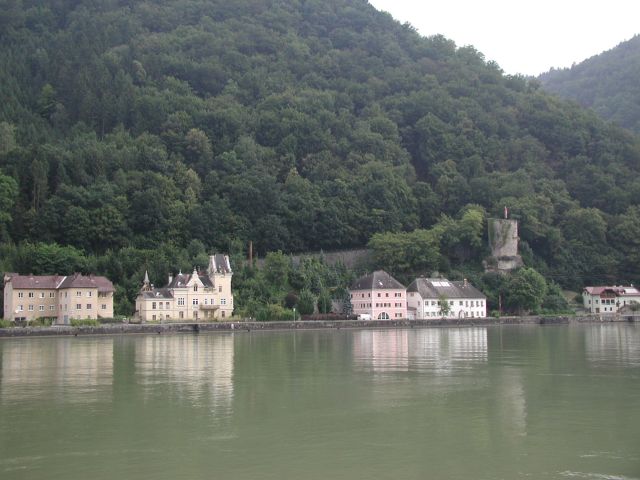
Day 4 -- Grein to Emmersdorf
After breakfast we had two chores to attend to in the little town of Grein. I needed a new guide book to the Danube path (having lost mine), and Len needed to find a photo shop that could tell him whether his damaged camera was actually taking pictures. Since Grein was essentially only one little square, I had doubts that we could accomplish either of these tasks.
There was an "eTech" store on the square. We weren't sure what kind of store that was, but we saw some hi-fi equipment in the window, and there weren't any other stores that looked like places you could ask about digital cameras, so in we went. Inside, a young woman directed us to a young man. He looked like a techie, and with hardly a word he pulled the compact flash card from Len's camera and inserted it into a slot in a computer. And there on the screen was the most recent picture that Len had taken. His camera worked, even though you couldn't tell because of the broken display. That made both of us happy.
Across the street was a very small book store. Inside the store there were almost no shelves, only a few books behind the counter. If it hadn't for Len's persistence, I would have left without asking about the guide book. Len pointed to his own guide book. "Do you have this?" he asked.
"Of course," said the woman behind the counter.
"In English?"
"Yes," she said simply, and reaching behind the counter she pulled out a pile of guide books in English and handed me one. I had been prepared to buy a copy in German; I just needed the maps. I was glad to pay the price, about $18, which was considerably more than the book had cost on the Internet. It just goes to show how popular the Danube path is when such a tiny town has a stack of the guide books in English. And, in fact, looking back on the trip I can't recall encountering a single other American biker on the path, although there were English people and presumably other bikers who didn't speak German but could understand English.
The morning was overcast and threatening rain as we headed back west along the Danube in order to get a bridge across to the other side. I was debating whether or not to try to cover my precious new guide book from any rain droplets, but I kept hesitating, and so did the rain. As we biked eastward the sky slowly began to clear.

Leaving Melk, going back upstream to get to the bridge
The path veered away from the river for awhile, giving us a nice change of pace. As it came back to the river bank we could see a big bridge up ahead, but there was no indication of a bridge on our GPSs. This mystery was cleared up when closer inspection showed that the bridge was a power station. The guide book says that bikes can cross the dam at the power station, but we weren't interested in doing that.
After about ten miles of biking we were coming into the town of Ybbs, however that's pronounced. The guide book said it was interesting, so we decided to visit the town center. The path signs guided us away from the river and alongside backyard gardens. Soon we reached a roundabout, those dreaded intersections where bikes don't seem to be welcome. It looked like we were headed out of town. Len asked a lady there where the "centrum" was. She pointed back the way we had come.
So back along the gardens, but this time we made a one-block turn inland, and there was the town square of Ybbs. The bike path signs had cleverly avoided any mention of the fact that the town was one-block to the right. In fact, this was true in a number of other towns too. The bike path naturally tries to avoid town centers, but it might at least tell you where they are.
After walking around Ybbs and visiting its pretty church, we biked once again through the gardens and back to the roundabout. There was a grocery store at the intersection, and once again we stocked up for lunch. As we were leaving, we ran into the family from Belgium with the 80-year old grandmother again. I had been saying that maybe she wasn't actually biking the whole path, but she proved me wrong several times. A real trooper.
We looked for a place to eat lunch as we biked away from Ybbs. The path ran along a highway that was crowded with industrial facilities. I think it was the ugliest half-mile of the entire Danube path. Certainly there was no place for lunch.
A little later we sat on a bench by an empty soccer field and ate our sandwiches. Afterwards, biking along the river among wet bushes we felt bugs on our faces. That happened several times during the trip. Not terrible, but unpleasant.
I could hear lots of German conversation behind me, getting closer. Soon I was passed by a troop of industrious-looking kids in scout uniforms being herded by a militant-sounding girl. Just as they were catching up with Len, ahead of me, everyone was stopped by the presence of a big tree that had fallen across the bike path. The last hour had been so boring that the tree was the highlight of the afternoon so far. I was telling Len that I thought of the kids as "ankle-biters", the term my own grown children used for little aggressive kid skiers. Len asked me to explain this, and I couldn't. I still think of them as ankle-biters, though.
Far ahead we could see yet another large church on a hill over the river. There had been lots of those, so I didn't pay it any special attention. I should have -- it was the famous monastery at Melk.
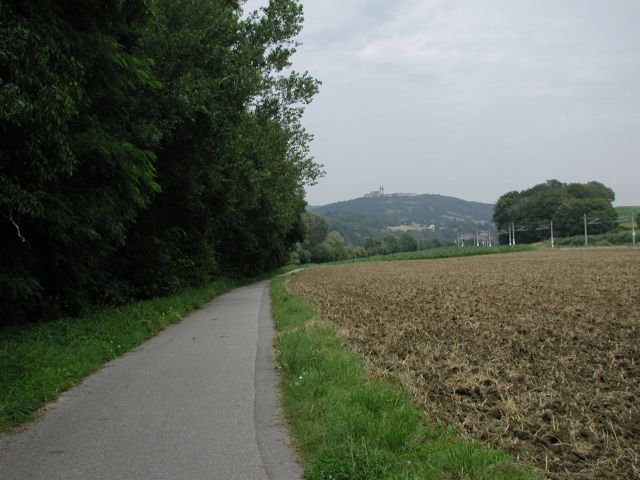
Far ahead, the monastery at Melk begins to be seen
Closer and closer we came to the monastery until we reached the outskirts of Melk. Now the monastery loomed huge on a hill above us. I could see little figures -- people -- walking on the terrace there.
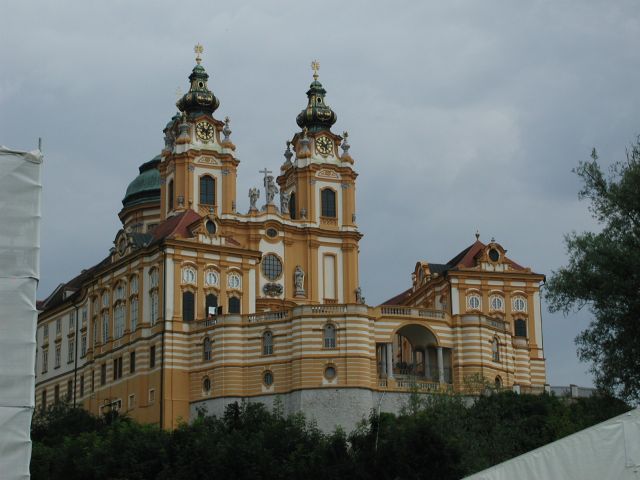
Looking up at the Monastery as we come into Melk
We parked our bikes on the main square of Melk, which was a cute little town, but utterly dominated by the monastery above. I could understand how people would be in awe of religion, living in the shadow of such a place.
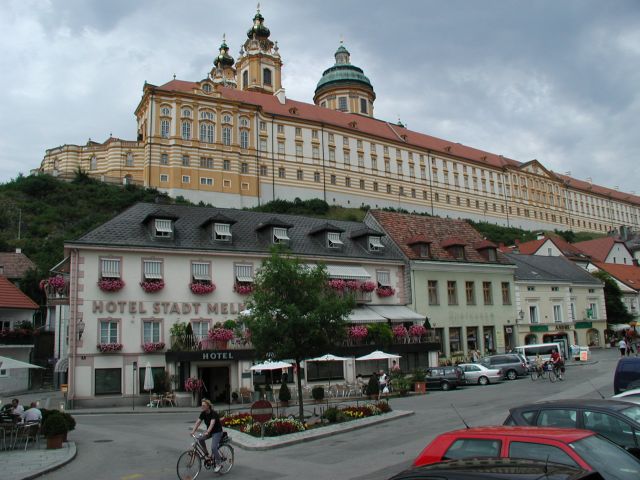
The main square of Melk, dominated by the monastery
We asked someone how to get to the entrance of the monastery, and they pointed up the street. We walked along the shops, and then turned left up a long, steep flight of stairs. At the top was the entrance to the monastery. There were some bikes parked there, and Len was saying that we should have biked up. I didn't think so.
We paid an admission fee (6 euros), and walked through several impressive courtyards before entering the museum part of the monastery.
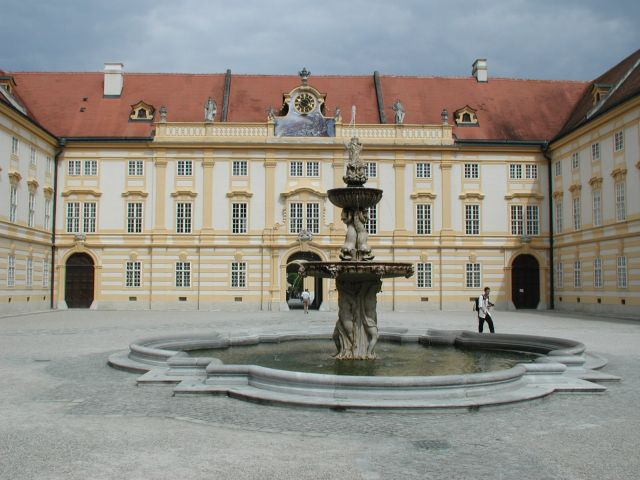
An interior courtyard in the Melk monastery
In the museum wing of the monastery were a number of rooms with displays of religious and historical artifacts. The initial four or five rooms were all done in different colors of light. It was quite effective, and several times I said that I couldn't recall seeing such a well done display.
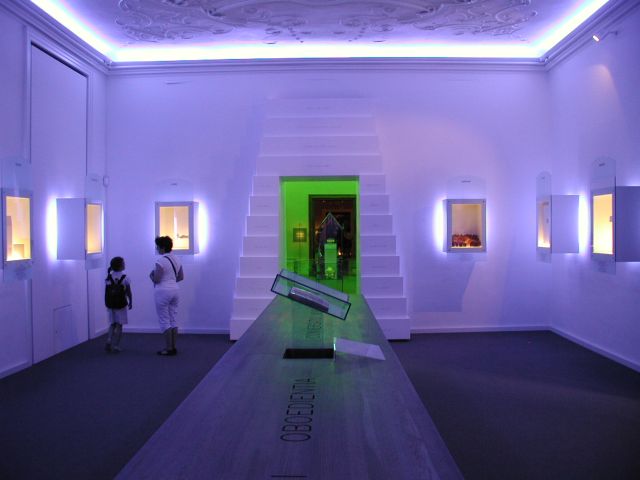
The "blue" room at Melk
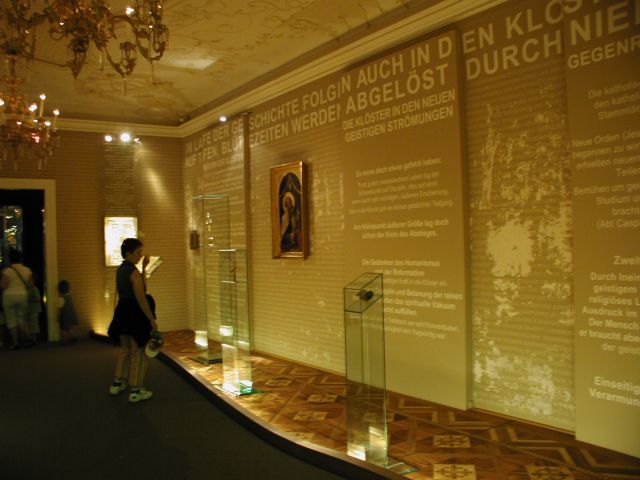
The "gold" room at Melk
There was a room with counter-reflecting mirrors, so that you would see endless reflections of your image as you walked through. Too many of me. Yet another room had projected displays, giving a 360-degree panorama on the walls. It featured ordinary people doing ordinary things, but maybe I didn't watch closely enough.
Each room had plaques on the end wall, in German and English, giving some information relevant to the contents of the room. What I really wanted was some history of the monastery, but most of the plaques were about religion and religious history. This was a Benedictine abbey, and the monks were very strict and ascetic, practicing extreme self-discipline. Nonetheless, they apparently lived in the midst of opulence.
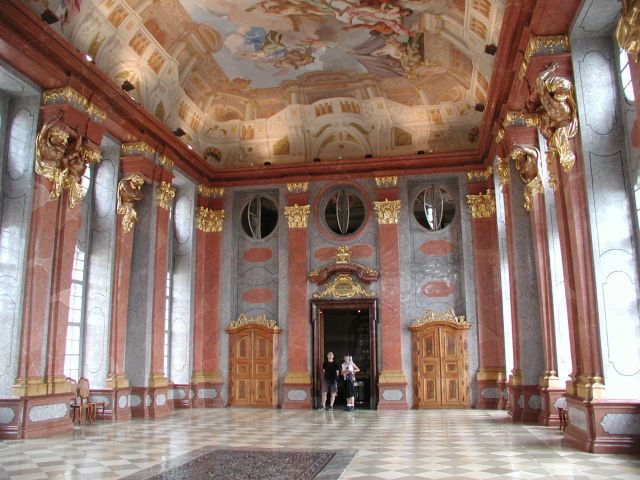
Room in the abbey at Melk
Now it was our turn to walk on the balcony and to be one of the tiny figures we had seen from afar.
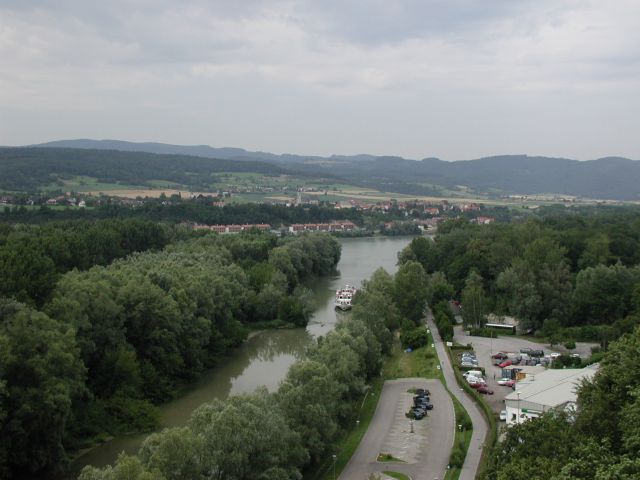
View from the balcony at the abbey in Melk
The library at the abbey is said to be quite famous. I believe that it contained over 100,000 volumes
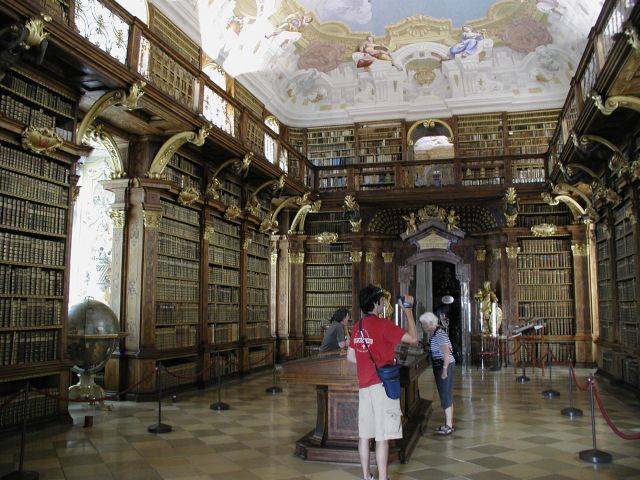
The library at the abbey
Len was having some trouble here at the abbey. Flash photography was prohibited, but without the display on his digital camera, how was he to set it not to flash? In a corner of one room he crouched, taking several dozen practice shots with different, arbitrary settings. His camera flashed every time. So I do have some pictures that he doesn't have.
The church inside the abbey was spectacular, with gold everywhere. I couldn't help but think of the paradox of the ascetic monks, surrounded by all these treasures. I kept wondering how they afforded all this, but one of the plaques told me that they lived on feudal taxes. I guess they owned all the land around.
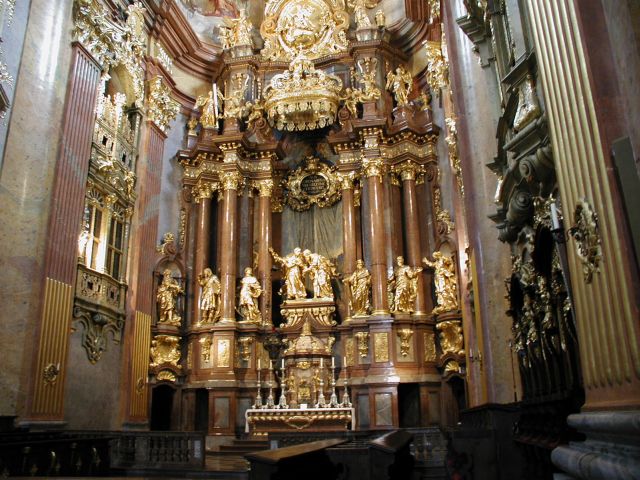
Above the altar at the abbey of Melk
Outside the abbey there was a large park, so the monks could contemplate nature and meditate appropriately. We spent a little time there, and then headed back to our bikes.
Our hotel for that evening was across the river from Melk in the little town of Emmersdorf. (I'm going to forget the names of most of these towns by next week.) To get there, we had to cross a bridge at the east end of Melk. As we biked along the river path, we could see the big bridge high above us. As often happened with a bridge, we wondered: how do we get up there? This time there was a steep dirt path leading up to the bridge. A tough climb, but not overly long.
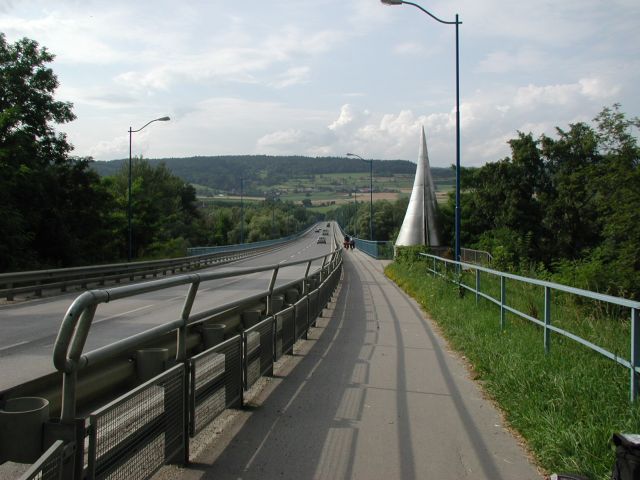
The big bridge at Melk
At the far end of the bridge was a roundabout, and we did a 3/4 turn and headed back west towards Emmersdorf. Once again the instructions in our information packet about finding the hotel were misleading. But Emmersdorf was very small, and it would be hard not to find the hotel, the Zum Schwarzen Baren. The mileage on my GPS for the day was 37.2 miles.
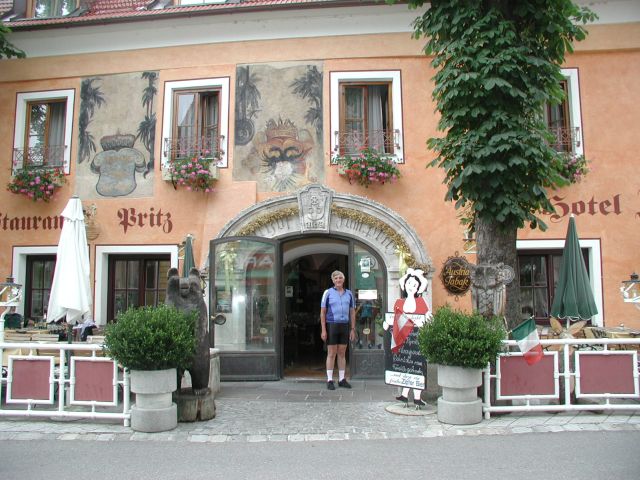
The hotel in Emmersdorf
This was a pretty hotel with modern furnishings -- perhaps the best hotel rooms we had on the trip. Even though the hotel looks ancient, it was built in 2002. In fact, the whole town seemed to be a prototypical Austrian town built in Disneyland for the delight of tourists.
We ate outside at our hotel, on the right as you see in this picture. Our meal was typical of those we had on the trip -- wiener schnitzel and boiled potatoes.
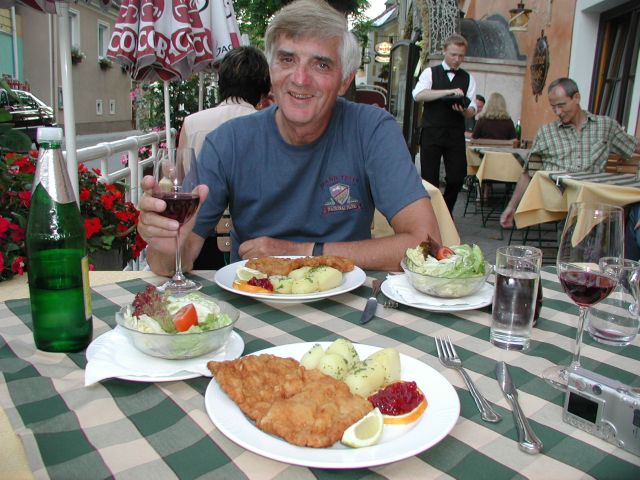
The meal in Emmersdorf -- a typical meal on the trip
After dinner we had the same problem we'd been having every night -- what should we tip? Neither of us had read any book about the custom in Austria, and we hesitated to ask a waiter. Each night we had observed other diners, and mostly they didn't seem to leave anything. We paid by credit card, and the slips we signed had no place to add a tip. But tonight Len had asked the reception clerk, who said 10% would be ok.
Neither of us had any coins for the tip. They were back up in our hotel rooms. I suggested that we flip a coin to see which of us should go up to his room to get some coins. We laughed about this paradox. Instead, we flipped a room key and Len lost. He claimed that I had cheated, but he got the coins for the tip.
Proceed to Day 5 of the Danube trip
Back to the Danube overview page